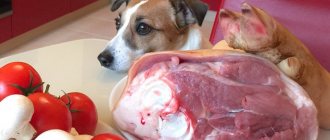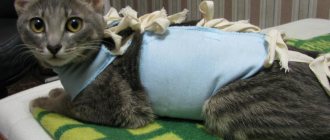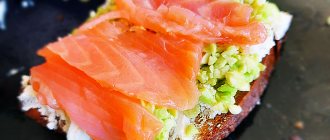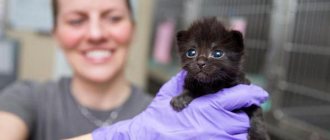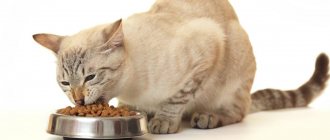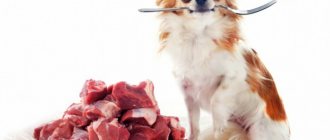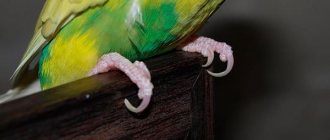Veterinarians believe that chicken meat is a healthy product for cats due to its high protein content, micro- and macroelements. The pet's diet should also contain by-products - kidneys, liver, hearts and stomach. Poultry is the healthiest because it does not contain antibiotics or salt, which is used to artificially increase weight.
Is it possible to feed cats raw chicken?
A balanced natural diet includes a significant intake of animal protein, which is most easily digestible by carnivores.
A cat's short intestinal tract is genetically designed to digest soft meat fibers. Chicken fillet has a number of advantages:
- contains essential amino acids;
- low in calories, low in fat, rich in proteins;
- easy to digest;
- inexpensive.
Raw broiler chicken meat is preferable to boiled meat in a cat’s diet. Cooking destroys most of the vitamins and microelements. The stomach and digestive tract of cats are well adapted to digest raw meat. Boiled chicken is dehydrated and creates a risk of constipation. The raw product takes longer to digest and saturates the pet longer.
Chicken breast (dietary white meat) contains little cholesterol and is rich in magnesium. Legs (red meat) contain a high content of iron and zinc. More juicy, they are more readily eaten by cats.
Chicken by-products:
- Liver - contains iron, folic acid, vitamins A, B, C and D. It can cause diarrhea, it is included in the diet 1-2 times a week.
- The heart and stomachs are made of muscle tissue and are difficult to chew. They are crushed before feeding.
By-products should make up 5-10% of a cat's diet.
In what form can cats be given meat, offal, eggs?
Not all types of meat are good for cats. Experts recommend feeding the animal chicken, turkey, lean parts of beef and lamb, rabbit, and veal. Pork, duck, goose, and excessively fatty meat are contraindicated for cats. It is advisable to buy products from trusted places, and be sure to ask for veterinary reports (without them, meat cannot be sold at all).
After purchasing, it is recommended to place it in the freezer for several days. Before feeding, scald with boiling water or cook a little.
The diet should also contain by-products. The most beneficial food for cats is liver. Unlike meat, it is recommended to give offal to your pet boiled. Chicken or beef liver should be boiled or well frozen, and scalded with boiling water before feeding. The first option is preferable, since the liver may contain helminth eggs and many harmful substances. Raw offal can also cause indigestion in cats, such as constipation or diarrhea.
Eggs also help provide the animal’s body with protein. There is no need to feed your cat raw eggs, as this can lead to salmonellosis. Cats eat boiled protein with pleasure. They also love yolk, but the quantity should be reasonable and you shouldn’t overdo it.
Chicken heads are not very healthy, but boiled chicken necks should be given. You can also offer your pet kidneys, hearts, and stomachs.
Cats do not need sinews, bones and other waste. Tubular bones can damage the animal's digestive tract. Meat should be given in the form of boneless fillet.
Cats can also have fish. This is also a useful and necessary protein for these animals. However, in the diet of castrated cats, the content of fish should be kept to a minimum. The fact is that this product is rich in phosphorus, and an excess of this element in the body of a castrated or sterilized cat provokes the development of urolithiasis.
Veterinarians recommend feeding cats sea fish.
River varieties contain more small bones and are more often infected with many types of helminths, most of which are dangerous for cats.
At what age can kittens be fed raw chicken?
Raw chicken is a tender, easily digestible product containing all the necessary substances for rapid growth. It can be given to kittens as complementary food starting from one month. At this time, babies still need mother's milk, but are already trying adult food. The breast is rolled in the freezer, small balls are formed from the minced meat and frozen. Food at room temperature is given in a bowl. The kitten eats with its mother, she teaches him to chew.
Two-month-old kittens can be given pieces of raw chicken, as solid food has a beneficial effect on the condition of baby teeth and forms a correct bite. After defrosting, a 40-50 g portion is cut into pieces that the kitten cannot swallow whole. By tearing off parts of the fibers, young seals train their jaw muscles, realizing their predator instinct.
At three months of age, chicken becomes a complete diet. Raw fillet can be given daily in an amount equal to 10% of the animal's weight.
How to give: the best recipes
It is useful to give your pet boiled breast with carrots and broccoli.
Cat owners recommend preparing the following simple chicken dishes for natural-fed pets:
- Chicken with vegetables. The breast is boiled and chopped. Add steamed broccoli and carrots in equal proportions. Then a small amount of fresh broth is introduced.
- Liver with garnish. Finely boil and chop 400 g of offal with the addition of 2 tbsp. l. olive or sunflower oil. Add 200 g of steamed oatmeal and 50 g of steamed green peas.
- Kidneys in sauce. Boil and chop 200 g of chicken kidneys. Add 4 tbsp. l. prepared oatmeal and ¼ cup grated carrots. Melted butter of medium fat content - 30 g is poured on top. Then 70 ml of yogurt without additives is added.
- Nutritious breakfast. Boil 70 g of rice. It is better to use unrefined, as it improves intestinal motility. Combine 1 boiled chicken egg in one plate, 1 tbsp. l. chopped carrots and boiled green beans and 20 g of chopped chicken fillet. 3 tsp is introduced. olive fruit oils.
If your cat previously ate exclusively dry food, raw chicken may not be of interest to her. Veterinarians advise boiling it and adding treats that your pet loves.
For babies and older cats, veterinarians recommend placing cooked food in a blender to facilitate digestion and prevent constipation. It is not enough for cats to eat meat in its pure form; the menu must be supplemented with sources of carbohydrates and fiber - bran, vegetables or fruits.
How to properly feed chicken breast and fillet to cats
You cannot feed your animal chicken alone - you need to alternate it with beef, rabbit, turkey and other sources of proteins.
A serving of chicken fillet for one feeding of an adult is 100-120 g. Before use, the chicken is defrosted and the resulting moisture is drained. A large amount of liquid indicates repeated freezing of the product or pumping of the pulp with a brine solution to increase the weight of the chicken. In this case, you should change the supplier.
The meat is cut into medium-sized pieces. The cat must bite and chew the food itself, stimulating the process of secretion of gastric juice. The chicken is served at room temperature, the product is not salted. It is unacceptable to feed raw and cooked meat at the same time. The release of various enzymes in the stomach leads to indigestion.
Can cats eat raw chicken?
Yes, such food may be present in their diet. Proponents of a raw food diet for cats usually mention that these feeding options allow them to consume food that they are able to digest. After all, no one cooks mice that a cat could catch in the house or on the street. Some people argue that the main benefit of feeding raw meat is that it mimics the food that cats naturally find and makes them feel better. However, there are significant differences between wild big cats and domestic pets.
Why is raw chicken dangerous for cats?
Only fillets and offal can be used for pet food. The tubular bones of chickens are hollow inside. Their fragments can injure the mucous membranes of the oral cavity and gastrointestinal tract. The heads and paws contain sharp parts and are not used as cat food. Tendons and cartilage require careful chewing, and cats swallow food in chunks. Rough food can cause inflammation of the gastric mucosa.
Chicken skin is difficult to digest and contains a large amount of fat. Acids and salts used when deboning poultry are preserved on its surface. To avoid digestive problems, the skin is carefully removed.
Broiler chicken is considered a dietary food, but often causes allergies in animals. It is not the product itself that causes painful reactions, but the antibiotics used in poultry farms and the chemicals used to process carcasses. A cat suffering from food allergies is given a small piece of chicken for the first time and its condition is monitored. The occurrence of diarrhea, watery eyes, and itching requires exclusion of the product from the diet.
Thermally untreated poultry may contain larvae and eggs of worms, pathogenic bacteria - salmonella, listeria. The product may be contaminated with E. coli.
The benefits and harms of chicken
Veterinarians recommend including chicken and offal in your pet’s diet, since this type of meat is low-fat and contains a lot of protein, macro- and microelements. However, you should not give your cat chicken every day; you need to alternate it with beef, rabbit and turkey so that the animal receives all the necessary vitamins. The pros and cons of the natural product are presented in the table:
| Positive aspects of the product | Cons for kittens and adult cats |
| High protein content | Fat content is higher than that of turkey |
| Ease of Digestion | Does not completely meet the body's needs for vitamins |
| Low chance of developing obesity | Antibiotic content in low-quality meat |
| Nicotinic acid strengthens the coat and maintains skin elasticity | Risk of parasite infection due to insufficient chemical treatment |
| Pyridoxine prevents anemia and skin diseases | Suitability of only some parts for consumption |
| Retinol strengthens natural immune defenses | Dangerous Bones |
| Phosphorus strengthens bones and fangs | Development of diarrhea due to overeating |
How to keep chicken safe for cats
Thermally untreated chicken may contain pathogens of toxoplasmosis, heterakis nematodes, and roundworm larvae. Deep industrial freezing at a temperature of -30˚C kills parasites in 6 hours. Household refrigerators are capable of providing a temperature of -18˚С.
Chicken meat is disinfected as follows:
- the bird is freed from skin and bones, cut into portions, placed in the freezer in plastic bags;
- parts of the carcass are frozen for at least 4 days;
- If necessary, fillet pieces are thawed and cut into pieces of the required size.
A cat's gastric juice is highly acidic, allowing it to cope with most pathogenic microorganisms. Salmonella and E. coli develop in dangerous quantities on stale, poor-quality products. Only fresh, uncured meat is suitable for feeding pets. It is preferable to purchase chickens from farms or in large stores and markets, where the products have a certificate of veterinary control.
Raw chicken meat processed at low temperatures is a healthy product, a source of easily digestible animal protein, vitamins and minerals. Cats and kittens willingly eat chicken without danger to their health.
Should I give raw or boiled meat?
Cats are carnivores, and in the wild no one cooks food for them, so the digestive system of pets can handle raw meat quite well. Therefore, such food is physiologically closer to cats. Another thing is the individual preferences of animals, which depend on what food the animal has been accustomed to since childhood.
Chicken meat is extremely rarely infected with helminths, so in this regard, a cat eating raw chicken is not in danger. Fish and other types of meat pose a great danger - for example, pork, which veterinarians generally do not recommend giving to cats.
Much more dangerous is the possible infection of a pet with salmonellosis. The causative agents of the disease are Salmonella - bacteria that remain active for a long time and are practically insensitive to low temperatures. But at +75 degrees, pathogenic microorganisms die. A 10-minute heat treatment will be enough to kill germs. A side effect of this treatment is that some of the nutrients are lost. The conclusion suggests itself: cats can have raw chicken meat, but only if it is purchased from a trusted seller and has been tested for salmonella.
Why is salmonellosis dangerous?
Salmonellosis is dangerous not only for cats, but also for humans. And more than a third of domestic animals with strong immunity that have eaten meat contaminated with salmonella will forever remain carriers of the pathology. The weakened body of a cat (small kittens, elderly animals) may not be able to cope with the infection.
The disease is always severe and accompanied by severe symptoms. You can observe in your pet:
- refusal of food;
- attacks of high fever;
- increased body temperature;
- apathy;
- diarrhea, feces have a dark, almost black color and a foul odor, and may contain streaks of blood;
- frequent vomiting with foam;
- cough;
- labored breathing.
The cat may experience severe pain in the abdomen, does not allow it to be touched, and shows aggression. With salmonellosis, the permeability of the vascular walls increases, which accelerates the penetration of pathogenic microorganisms into the body. Without prompt veterinary care, kittens, animals with low immunity and elderly animals die within 1-2 days from dehydration or sepsis.
Restrictions when feeding natural food
When accustoming a small cat to natural food, you need to carefully monitor the reaction to the products offered. Cats, like people, have allergies, sometimes quite serious.
You should be careful when giving your cat chicken, eggs, and dairy products. If the animal is reluctant to eat cereal, there is no need to force it. Whether you can give your cat raw meat or boil it is best to decide based on your pet’s preferences.
Under no circumstances should you offer your animal fatty meats (pork, lamb), butter, or fruit. Cats do not tolerate onions well in any form, both raw and boiled. Potatoes are also undesirable; they contain a lot of starch, which they cannot digest at all.
How to make meat safe for your cat
Many types of meat can be given to domestic cats. It is better to regularly change the types of meat, giving preference to organic types, the cultivation of which did not use chemical additives and antibiotics. If the owner gives the pet the same type of raw meat, the risk of developing a deficiency of beneficial nutrients increases.
The following types of raw meat are suitable for feeding cats:
- chicken fillet (breast) and thigh meat;
- pieces of steak - it is recommended to take pieces of meat with veins, since such types of meat are preferable for digestion and improving the condition of the gums;
- pieces of rabbit meat;
- turkey fillets, wings and thighs;
- chicken necks and wings;
- lamb heart and kidneys.
When choosing the type of raw meat for a pet, the owner must pay special attention to the quality of the product. It is forbidden to feed the animal spoiled food (meat with flavor). When buying meat in a supermarket, you must carefully monitor the production date indicated on the packaging.
Giving your cat sausages instead of raw meat is prohibited. Ready-made semi-finished products contain a large amount of sodium chloride and spices that are prohibited for consumption by pets.
Can kittens have boiled meat?
Does a kitten need to cook meat? No no need. He, being a predator, does not need this. Yes, the kitten looks weak and fragile. But that's what you think until you put a piece of raw meat in front of him.
And, nevertheless, kittens can also have boiled meat, it is not poison. However, such nutrition has a number of disadvantages. Firstly, it, as we have already written, is almost completely devoid of useful substances. On a boiled diet, a kitten has to add special vitamin and mineral complexes to its food, which are expensive and often do more harm than good. Secondly, boiled meat is dehydrated, meaning that eating it in large quantities creates a risk of constipation. Thirdly, it is raw fiber that helps adjust the kitten’s digestive enzymes in the right way.
Well, if you only occasionally want to treat your cat to a piece of boiled meat, that’s okay. The main thing is that the basis of the diet is raw.
Is half-raw chicken dangerous?
Owners of four-legged friends will be interested to know whether it is possible to give their kitten half-raw chicken. The properties of chicken scalded with boiling water will remain virtually unchanged. But the procedure of such treatment does not guarantee complete disposal of pathogenic microorganisms.
Meat purchased in a supermarket or specialty store is completely safe for health, as it does not contain harmful microflora or helminth eggs. So it’s hardly necessary to scald the product with boiling water to get half-baked chicken. The baby needs raw meat more than boiled or dry store-bought food.
Possible problems
Sometimes kittens have problems when feeding meat. Let's list the most typical ones.
Kitten vomits raw meat
If a kitten vomits raw meat, then most likely he ate too much at one time. Some kittens do not know how to control their eating behavior, attacking food like crazy and eating everything they see. Such kittens should be limited by giving food in strictly measured portions. Even if it seemed to you that the kitten vomited after eating a small amount of meat, perhaps you were just measuring by eye and that’s why its portion seemed small. So use a kitchen scale.
Also, the cause of regurgitation may be intolerance to any type of meat. Pay attention to what exactly the kitten regurgitates. If it is always the same type of meat, you will have to give it up.
In addition, regurgitation of hard food such as gizzards or bones may occur.
In addition, if the kitten is 2-3 months old or more, and he is accustomed only to industrial food, problems associated with enzyme deficiency may arise with the consumption of meat.
EXPERT COMMENT: CANDIDATE OF BIOLOGICAL SCIENCES GALINA CHILIKINA
“Any dry food is granules that have a porous structure and contain almost digested food, so enzymes are not required to digest dry food. Entering the stomach through the esophagus, these granules begin to absorb gastric juice, under the influence of which they turn into a homogeneous liquid gruel, which in turn enters the small intestine, where absorption occurs. The movement of this liquid gruel from the stomach into the intestines occurs almost by gravity, so contraction of the walls of the stomach and intestines is not required. Therefore, the motility of the gastrointestinal tract in cats eating exclusively dry food is very sluggish. Thus, dry industrial food takes over the functions of the body, and this leads to the fact that the cat does not produce enzymes intended for breaking down and digesting natural food.”
Kitten eats only meat
This is normal, no need to worry. The kitten is a predator, it is supposed to eat meat. All other products (fermented milk, fish, vegetables, eggs) are food additives that may not be in the diet. And even more so, do not feed kittens cereals that are harmful to them.
Kitten doesn't want to eat meat
But this situation, on the contrary, requires careful study. All kittens, when they reach the age of 1 month, are already able to absorb some amount of meat. After all, at 2 months they will have to wean themselves from their mother’s breast and eat on their own. If a very small kitten refuses meat, then it is simply too early for him to eat it. If we are talking about a 2-month-old kitten, then it needs to be examined. Typically, this behavior is associated with gastrointestinal pathologies.
Some cats refuse to eat meat if they have been taught to eat dry food. Adult cats can sometimes be very difficult to retrain. But with kittens that previously ate dry food, as a rule, there are no problems when switching to meat. Kittens are open to everything new and it is quite simple to form in them the food preferences needed by the owner.
What kind of meat should you not give?
Freshness is of great importance. There should not be any elements with a stale smell. In nature, an animal eats immediately after a hunt, so any decrease in the quality of feeding a pet will lead to serious disruptions to the gastrointestinal tract. The food must be prepared from fresh product, then frozen (blast freezing preserves nutrients), defrosted in cold water, and after defrosting, stored in the refrigerator for no more than 12 hours. This can only be done once, given that repeated freezing reduces the nutritional properties of the product. No need for salt either. Humans are accustomed to the variety of flavors achieved by using spices, but this is unacceptable for cats. There are also restrictions on the type, for example, pork will be too fatty and heavy food for a cat.
Minced meat is a good option if it is made from good ingredients and mixed with pieces that are very important for dental health.
Important: all products offered to animals must have a veterinary certificate.
Bones are a must in the diet. SUPERPET uses chicken, turkey and duck necks that are ground into fine grains. This is necessary to ensure that your pet’s food is complete. The main thing is that the required ratio of calcium and phosphorus is maintained - 1.3:1. Crushed neck bones in their raw form are perfectly absorbed and digested in the acidic environment of the stomach. Smoked and fried foods are also not allowed; this is a real blow to digestion and immunity. There are no useful substances there anymore, and irritation of the stomach and liver is guaranteed. If the pancreas is weak, it will also be harmed. More details about what should not be in the diet are presented in the article.
Nutrition for sterilized pets
Natural food is also beneficial for these pets. Can neutered cats be given raw meat? Yes, but you need to calculate the amount correctly.
Neutered animals are less active and more prone to obesity. They can be fed in smaller portions, focusing on lean meats and pureed boiled vegetables. It is also better to choose dairy products for sterilized cats with low fat content.
Regardless of the choice of food for your pet, the main thing is that he is cheerful and energetic, with shiny fur and a good appetite.
How much meat should I give my kitten?
Raw meat for 1 month old kittens is served in a bowl directly into the nest. The mother eats the same food as her kittens. They look at their mother and learn to do everything right. The lactating female is not limited in food: she is allowed to eat several times a day. Let mom eat enough. And kittens will not eat too much meat, because... their main food is still milk. Meat in this case is just training for now.
Raw meat for kittens at 2 months already becomes a complete meal. At this time, they switch to their own provision, gradually abandoning their mother's milk. At this time, the breeder feeds them either natural food, industrial food, or a mixture. Many breeders prefer the mixed version, because... It is unknown what exactly the kitten will eat in its new home. If this is a different type of feeding, then he may develop digestive problems - and the buyer will file a claim with the breeder.
EXPERT COMMENT: CANDIDATE OF BIOLOGICAL SCIENCES GALINA CHILIKINA
“If the nursery fed only one natural female, and the new owners want to switch it to dry food, very serious digestive problems may arise, since aggressive enzymes will be released with the gastric juice, necessary for digesting meat, which are not needed for drying. If, on the contrary, the kitten in the nursery was fed exclusively dry food, and its new owners want to switch it to healthy natural food, the kitten will experience a phenomenon such as an inability to digest this food, since the stomach does not produce the enzymes necessary for this, so the kitten will constantly regurgitate this food, which may be perceived by the owners as a pathology. Diarrhea and other phenomena are also possible.”
Raw meat for kittens at 3 months is already the main food. From 3 months, most have lactose intolerance: due to the large amount of milk, pets can become bloated and diarrhea.
Article continues after advertisement
Small kittens are not limited in the amount of food they eat, giving meat several times a day. But you shouldn’t let them eat a lot at one time. The daily dose is approximately up to 10% of the kitten’s body weight.
At 3 months, many kittens already find a new home, and owners cannot always feed them several times a day. In this case, it is not necessary to switch to dry food, which is always available. A three-month-old kitten can already be fed raw meat like an adult animal: twice or thrice a day, also in a total amount of up to 10% of body weight.
For more information on how often to feed raw meat to your kitten, follow this link. The article indicates feeding standards for Scottish kittens, but the feeding principles described are valid for any breed.
Chicken for kittens as a first food
If you have a question: “Is it possible to give chicken to kittens as a first food?”, then the answer is: - Yes! At 3–4 weeks of life, when the pet has already grown up and its digestive system has adapted to mother’s milk, the first complementary foods are introduced.
For this purpose, fresh chicken meat is used because of its lightness and quick digestibility. Bones, veins and fat accumulations are removed. From 5–6 weeks, boiled beef, pork, vegetables, cereals, dairy and other products are added to the diet. This is necessary to expand the diet and make it more complete.
Only chicken in the diet
Is it possible to give a cat only raw chicken? Definitely not. The reason is the lack of microelements that make up a balanced daily diet. If your pet eats homemade food, it is recommended to combine meat with offal - vegetables, vitamins, fiber.
Important! If you refuse dry food, contact the veterinary hospital to approve the “menu”. The doctor determines the ingredients based on the results of the pet's examination. You need to stick to your feeding plan. Cats may not feel the need to eat more than necessary.
